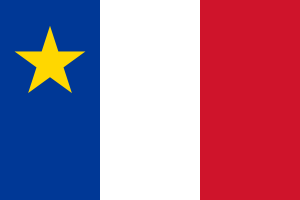Flag of Acadia


The flag of Acadia was adopted on August 15, 1884, at the Second Acadian National Convention held in Miscouche, Prince Edward Island, by nearly 5,000 Acadian delegates from across the Maritimes. It was designed by Father Marcel-Francois Richard, a priest from Saint-Louis-de-Kent, New Brunswick. The Musée Acadien at the Université de Moncton has the original flag presented by Father Richard to the 1884 Convention. It was sewn by Marie Babineau.
According to Perry Biddiscombe:
The Tricolour represents the Motherland of the Acadians. The yellow star, the Stella Maris, is the symbol of Mary, Acadian national symbol and patron of the mariners. It is set on the blue stripe, because blue is the colour of Mary. The yellow colour of the star represents the Papacy.[1]
Father Richard selected the French flag as the basis of the Acadian one to underline the adherence of the Acadians to the French civilization:
I wish that Acadia had a flag reminding not only that its children are French, but also that they are Acadians
Father Richard saw the star in the blue band as "the distinctive emblem of our Acadian nationality", representing the star of the Blessed Virgin of the Assumption, patron of the Acadians. The star also represented the starfish that guides the sailor "through storms and reefs".[2] The gold colour of the star was chosen by Father Richard because it is the colour of the Pope, in order to show both the adherence of the Acadians to the Roman Catholic Church and the role of the Church in the history of Acadia.
The flag of Acadia has a complicated vexillology. The first Acadians arrived in Nova Scotia from France as early as 1604, but as John Powell writes in The Encyclopedia of North American Immigration, "the limited flow of immigrants, chiefly from the French region of Poitou, came to a standstill between 1654 and 1667."[3] This separates the Acadians from the events of the French Revolution by more than a century. Despite there being no relationship between Acadia and France in 1789, the flag of the Revolution was selected in 1884 to "represent the Motherland of the Acadians" [Biddiscombe] rather than the Fleur-De-Lis. That design, the traditional symbol of the Kingdom of France,[4] was selected for the flags of the Quebecois and Cajuns, who both rejected use of the Tricolour. The Star of the Virgin represents the Catholic Church, yet here it is affixed it to a symbol of French secularism. This is especially ironic as in 1793, French Catholic priests had been forced to seek asylum in Nova Scotia after fleeing the religious persecutions of Revolutionary France.[5]
See also
Sources
- ↑ Perry Biddiscombe (1990). "Le tricolore et l'étoile; The Origin of the Acadian National Flag, 1867–1912". Acadiensis. 20 (1): 120–147.
- ↑ The Cajuns website
- ↑ Powell, John (2005). The Encyclopedia of North American Immigration. New York, New York: Facts on File, Inc. p. 1. ISBN 0-8160-4658-1.
- ↑ Gwynn-Jones, LVO, FSA, Peter (1998). The Art of Heraldry: Origins, Symbols and Designs. London: Prospero. p. 51. ISBN 1 894102 34 7.
- ↑ Richard, Edouard (1895). Acadia: Missing Links in a Lost Chapter of American History, vol. 2. New York: Home Book Company. p. 335.
External links
| Wikimedia Commons has media related to Flag of Acadia. |
